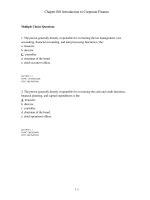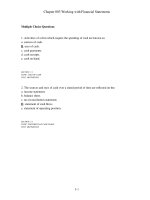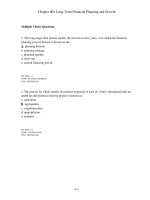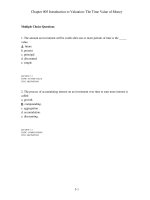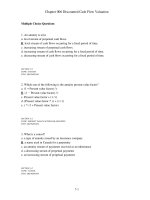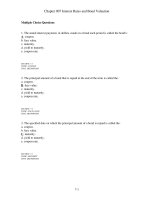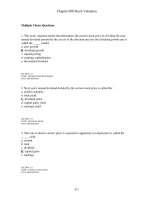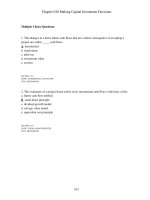Test bank corporate finance 8e ros chap004
Bạn đang xem bản rút gọn của tài liệu. Xem và tải ngay bản đầy đủ của tài liệu tại đây (539.07 KB, 44 trang )
Chapter 004 LongTerm Financial Planning and Growth
Multiple Choice Questions
1. The longrange time period, usually the next two to five years, over which the financial
planning process focuses is known as the:
A. planning horizon.
b. planning strategy.
c. planning agenda.
d. shortrun.
e. current financing period.
SECTION: 4.1
TOPIC: PLANNING HORIZON
TYPE: DEFINITIONS
2. The process by which smaller investment proposals of each of a firm's operational units are
added up and treated as one big project is known as:
a. separation.
B. aggregation.
c. conglomeration.
d. appropriation.
e. striation.
SECTION: 4.1
TOPIC: AGGREGATION
TYPE: DEFINITIONS
3. The financial planning method in which accounts vary depending on a firm's predicted
sales level is called the _____ approach.
A. percentage of sales
b. sales dilution
c. sales reconciliation
d. commonsize
e. timetrend
SECTION: 4.3
TOPIC: PERCENTAGE OF SALES APPROACH
TYPE: DEFINITIONS
4-1
Chapter 004 LongTerm Financial Planning and Growth
4. The dividend payout ratio is calculated as:
a. net income minus additions to retained earnings.
b. cash dividends divided by the change in retained earnings.
C. cash dividends divided by net income.
d. net income minus cash dividends.
e. one plus the retention ratio.
SECTION: 4.3
TOPIC: DIVIDEND PAYOUT RATIO
TYPE: DEFINITIONS
5. The retention ratio is calculated as:
a. one plus the dividend payout ratio.
B. the additions to retained earnings divided by net income.
c. the additions to retained earnings divided by dividends paid.
d. net income minus additions to retained earnings.
e. net income minus cash dividends.
SECTION: 4.3
TOPIC: RETENTION RATIO
TYPE: DEFINITIONS
6. The capital intensity ratio is the:
a. ratio of fixed assets to current assets.
b. ratio of total assets to total equity.
c. amount of fixed assets required to generate $1 in sales.
D. amount of total assets required to generate $1 in sales.
e. the amount of sales generated from every $1 in total assets.
SECTION: 4.3
TOPIC: CAPITAL INTENSITY RATIO
TYPE: DEFINITIONS
4-2
Chapter 004 LongTerm Financial Planning and Growth
7. The internal growth rate of a firm is best described as the:
a. minimum growth rate achievable if the firm does not pay out any cash dividends.
b. minimum growth rate achievable if the firm maintains a constant equity multiplier.
C. maximum growth rate achievable without external financing of any kind.
d. maximum growth rate achievable without using any external equity financing while
maintaining a constant debtequity ratio.
e. maximum growth rate achievable without any limits on the level of debt financing.
SECTION: 4.4
TOPIC: INTERNAL GROWTH RATE
TYPE: DEFINITIONS
8. The sustainable growth rate of a firm is best described as the:
a. minimum growth rate achievable if the firm does not pay out any cash dividends.
b. minimum growth rate achievable if the firm maintains a constant equity multiplier.
c. maximum growth rate achievable without external financing of any kind.
D. maximum growth rate achievable without using any external equity financing while
maintaining a constant debtequity ratio.
e. maximum growth rate achievable without any limits on the level of debt financing.
SECTION: 4.4
TOPIC: SUSTAINABLE GROWTH RATE
TYPE: DEFINITIONS
9. Which of the following are basic components of a corporation's financial plan?
I. dividend policy
II. net working capital decision
III. capital budgeting decision
IV. capital structure policy
a. I and IV only
b. II and III only
c. I, III, and IV only
d. II, III, and IV only
E. I, II, III, and IV
SECTION: INTRODUCTION
TOPIC: FINANCIAL PLANNING ELEMENTS
TYPE: CONCEPTS
4-3
Chapter 004 LongTerm Financial Planning and Growth
10. Financial planning:
a. focuses solely on the shortterm outlook for a firm.
b. forecasts the financial position of a firm on a divisional basis only.
C. generally forecasts the financial position of a firm for the next two to five years.
d. is a process that firms undergo once every five years.
e. is limited to projecting the net income of a firm over the planning horizon.
SECTION: 4.1
TOPIC: FINANCIAL PLANNING
TYPE: CONCEPTS
11. Financial planning:
a. encourages managers to separate their goals from their plans.
b. is generally based on the bestcase scenario.
c. is beneficial to smaller firms but has limited value to larger firms.
D. helps managers establish priorities.
e. prevents firms from encountering surprise events.
SECTION: 4.1
TOPIC: FINANCIAL PLANNING
TYPE: CONCEPTS
12. Managers of Today's World are currently in the process of updating their longrange
financial plans and preparing revised pro forma statements. During this process, the managers
will most likely focus on the next:
a. 6 to 12 months.
b. 1 to 3 years.
c. 1 to 6 years.
D. 2 to 5 years.
e. 2 to 10 years.
SECTION: 4.1
TOPIC: PLANNING HORIZON
TYPE: CONCEPTS
4-4
Chapter 004 LongTerm Financial Planning and Growth
13. One of the primary benefits of aggregation is gaining an understanding of the:
a. interactions of the net working capital.
B. total investment needs of the firm.
c. tradeoffs between debt and equity.
d. tradeoffs between the dividend policy and the plowback ratio.
e. total asset turnover ratio.
SECTION: 4.1
TOPIC: AGGREGATION
TYPE: CONCEPTS
14. Which one of the following is a benefit of financial planning?
a. determining the amount of debt required over the planning horizon with absolute certainty
b. knowing with certainty the amount of sales that will be generated over the planning horizon
c. avoiding all surprises during the planning horizon
d. allowing growth to exceed the financing available for that growth
E. ascertaining the feasibility of a firm's goals
SECTION: 4.1
TOPIC: FEASIBILITY
TYPE: CONCEPTS
15. Pro forma financial statements are:
I. generally based on projected sales.
II. guarantees of future performance.
III. the output from a financial planning model.
IV. projections of a firm's future financial position.
a. IV only
b. I and III only
c. I and IV only
d. II and IV only
E. I, III, and IV only
SECTION: 4.2
TOPIC: PRO FORMA STATEMENTS
TYPE: CONCEPTS
4-5
Chapter 004 LongTerm Financial Planning and Growth
16. When utilizing the percentage of sales approach, managers:
I. determine the level of sales required based on the desired profit margin percentage.
II. need to identify which expenses are variable and which are fixed.
III. need to determine the capital intensity ratio.
IV. can ignore any projected dividends.
a. I and II only
B. II and III only
c. III and IV only
d. I, II, and IV only
e. I, III, and IV only
SECTION: 4.3
TOPIC: PERCENTAGE OF SALES APPROACH
TYPE: CONCEPTS
17. Sales forecasts are:
I. frequently based on macroeconomic projections.
II. often influenced by industry forecasts.
III. critical to the reliability of pro forma financial statements.
IV. generally the basis for projecting future asset requirements.
a. I and II only
b. III and IV only
c. II and III only
d. I, II, and III only
E. I, II, III, and IV
SECTION: 4.2
TOPIC: SALES FORECASTS
TYPE: CONCEPTS
4-6
Chapter 004 LongTerm Financial Planning and Growth
18. When constructing a pro forma statement, net working capital generally:
a. remains fixed.
b. varies only when the firm is producing at full capacity.
c. varies only if the firm maintains a fixed debtequity ratio.
d. varies only if the firm is producing at less than full capacity.
E. varies proportionately with sales.
SECTION: 4.3
TOPIC: PRO FORMA STATEMENTS
TYPE: CONCEPTS
4-7
Chapter 004 LongTerm Financial Planning and Growth
19. When fixed assets on a pro forma statement are projected to increase at a rate equivalent
to the projected rate of sales growth, it can be assumed that the firm is:
a. projected to grow at the internal rate of growth.
b. projected to grow at the sustainable rate of growth.
c. creating excess capacity.
D. currently operating at full capacity.
e. retaining all of its projected net income.
SECTION: 4.3
TOPIC: PRO FORMA STATEMENTS
TYPE: CONCEPTS
20. A firm is currently operating at full capacity. Net working capital, costs, and all assets
vary directly with sales. The firm does not wish to obtain any additional equity financing. The
dividend payout ratio is constant at 40 percent. If the firm has a positive EFN, that need will
be met by:
a. accounts payable.
B. longterm debt.
c. fixed assets.
d. retained earnings.
e. common stock.
SECTION: 4.3
TOPIC: PRO FORMA STATEMENTS
TYPE: CONCEPTS
21. The composition of the liability and equity sections of a pro forma statement depend most
heavily on a firm's:
a. net working capital policies.
B. financing and dividend policies.
c. desired level of liquidity.
d. capital budgeting and working capital policies.
e. level of capacity utilization and net working capital policy.
SECTION: 4.3
TOPIC: PRO FORMA STATEMENTS
TYPE: CONCEPTS
4-8
Chapter 004 LongTerm Financial Planning and Growth
22. You are comparing the current income statement of a firm along with a pro forma income
statement for next year. The pro forma is based on a five percent increase in sales. The firm is
currently operating at 82 percent of capacity. Net working capital and all costs vary directly
with sales. The tax rate and the dividend payout ratio are fixed. Given this,:
a. the net income shown on both statements is identical.
b. the tax rate is assumed to increase at the same rate as the sales.
C. the common size income statements for both years will be identical.
d. next year's increase in retained earnings will equal this year's increase in retained earnings.
e. total assets are required to also increase at a rate equal to the rate of sales growth.
SECTION: 4.3
TOPIC: PRO FORMA STATEMENTS
TYPE: CONCEPTS
23. Which of the following statements concerning pro forma financials are correct?
I. The pro forma level of sales should consider macroeconomic forecasts.
II. Pro forma statements should consider both the capital structure and the dividend policies of
the firm.
III. A pro forma balance sheet must always maintain a fixed debtequity ratio.
IV. A pro forma balance sheet must always consider the operating capacity level.
a. I and II only
b. III and IV only
c. I, III, and IV only
d. I, II, and III only
E. I, II, and IV only
SECTION: 4.3
TOPIC: PRO FORMA STATEMENTS
TYPE: CONCEPTS
4-9
Chapter 004 LongTerm Financial Planning and Growth
24. Which one of the following is required to create pro forma financial statements?
A. current capacity level of operations must be known
b. debtequity ratio must be constant
c. dividend amount must be constant
d. all expenses must vary directly with sales
e. firm must be projected to operate at full capacity
SECTION: 4.3
TOPIC: PRO FORMA STATEMENTS
TYPE: CONCEPTS
4-10
Chapter 004 LongTerm Financial Planning and Growth
25. Which of the following must you know to determine the fixed assets required to support a
given level of sales?
I. current amount of fixed assets
II. current sales
III. current level of operating capacity
IV. projected growth rate of sales
a. I and III only
b. II and IV only
C. I, II, and III only
d. II, III, and IV only
e. I, II, III, and IV
SECTION: 4.3
TOPIC: PRO FORMA STATEMENTS
TYPE: CONCEPTS
26. The plowback ratio:
a. is equal to net income divided by the change in total equity.
B. shows the percentage of net income available to the firm for future growth.
c. plus the retention ratio must equal one hundred percent.
d. is equal to the change in retained earnings divided by the dividends paid.
e. represents the earnings returned to the shareholders.
SECTION: 4.3
TOPIC: PLOWBACK RATIO
TYPE: CONCEPTS
4-11
Chapter 004 LongTerm Financial Planning and Growth
27. Alpha and Beta are two firms that are equal in every way except for their dividend payout
ratios. Alpha has a 30 percent payout ratio while Beta has a 40 percent payout ratio. Given
this difference,:
a. Alpha's profit margin next year will exceed the Beta's profit margin.
b. Alpha and Beta will continue to grow at the same rate over the next five years assuming
neither firm utilizes any external financing.
c. Alpha's plowback ratio is less than Beta's plowback ratio.
D. Alpha has higher internal rate of growth than does Beta.
e. Alpha has a lower sustainable rate of growth than does Beta.
SECTION: 4.4
TOPIC: PAYOUT RATIO
TYPE: CONCEPTS
4-12
Chapter 004 LongTerm Financial Planning and Growth
28. Which one of the following statements concerning the capital intensity ratio is correct?
a. The capital intensity ratio is equal to sales divided by total assets.
b. The lower the capital intensity ratio, the greater the amount of assets required to support
each dollar of sales.
c. A highly capitalintensive firm will have a low capital intensity ratio.
d. The capital intensity ratio is the amount of sales generated from each dollar of total assets.
E. The capital intensity ratio is the amount of total assets required to generate one dollar of
sales.
SECTION: 4.3
TOPIC: CAPITAL INTENSITY RATIO
TYPE: CONCEPTS
29. A firm is currently operating at full capacity and owns sufficient assets to just support that
level of sales. Sales are expected to increase at the internal rate of growth next year. Net
working capital and operating costs are expected to increase directly with sales. The interest
expense, the tax rate, and the dividend payout ratio are fixed. The net income is positive.
Assume you are comparing next year's pro forma statements to this year's financial
statements. Which one of the following values should be unchanged from this year?
a. profit margin
B. capital intensity ratio
c. debtequity ratio
d. dividend amount
e. plowback amount as a percentage of sales
SECTION: 4.3
TOPIC: PRO FORMA STATEMENTS
TYPE: CONCEPTS
30. Any external financing needed is generally covered by:
a. the net income retained by the firm.
b. adjusting accounts payable.
c. adjusting the projected cash balance.
D. adjusting the level of debt and/or equity.
e. the projected operating cash flow.
SECTION: 4.4
TOPIC: EXTERNAL FINANCING NEED
TYPE: CONCEPTS
4-13
Chapter 004 LongTerm Financial Planning and Growth
4-14
Chapter 004 LongTerm Financial Planning and Growth
31. Sales can often increase without increasing which one of the following?
a. accounts receivable
b. cost of goods sold
c. accounts payable
D. fixed assets
e. inventory
SECTION: 4.3
TOPIC: PERCENTAGE OF SALES APPROACH
TYPE: CONCEPTS
32. If a firm is at fullcapacity sales, it means the firm is at the maximum level of production
possible without increasing:
a. net working capital.
b. cost of goods sold.
c. inventory.
D. fixed assets.
e. the debt ratio.
SECTION: 4.3
TOPIC: FULLCAPACITY SALES
TYPE: CONCEPTS
33. All else equal, the internal growth rate increases when the:
a. retention ratio decreases.
b. dividend payout ratio increases.
c. net income decreases.
D. total assets decrease.
e. plowback ratio decreases.
SECTION: 4.4
TOPIC: INTERNAL GROWTH RATE
TYPE: CONCEPTS
4-15
Chapter 004 LongTerm Financial Planning and Growth
34. The external financing needed:
A. will decrease if the projected level of sales is decreased.
b. is unaffected by the dividend payout ratio.
c. must be funded by debt financing.
d. is prior to considering any potential increase in retained earnings.
e. assumes a firm is operating at full capacity.
SECTION: 4.3
TOPIC: EXTERNAL FINANCING NEEDED
TYPE: CONCEPTS
35. The sustainable growth rate will be equivalent to the internal growth rate when:
A. a firm has no debt.
b. the projected growth rate is equal to the internal growth rate.
c. the plowback ratio is positive but less than one.
d. a firm has a debtequity ratio exactly equal to one.
e. the dividend payout ratio is zero.
SECTION: 4.4
TOPIC: SUSTAINABLE GROWTH RATE
TYPE: CONCEPTS
36. The sustainable growth rate:
a. assumes there is no external financing of any kind.
B. is normally higher than the internal growth rate.
c. assumes the debtequity ratio is variable.
d. is based on receiving additional external debt and equity financing.
e. assumes that all income is retained by the firm.
SECTION: 4.4
TOPIC: SUSTAINABLE GROWTH RATE
TYPE: CONCEPTS
4-16
Chapter 004 LongTerm Financial Planning and Growth
37. If a firm bases its growth projection on the rate of sustainable growth, and has positive net
income, then the:
a. fixed assets will have to increase at the same rate, regardless of the current capacity level.
b. number of common shares outstanding will increase at the same rate of growth.
c. debtequity ratio will have to increase.
D. debtequity ratio will remain constant while retained earnings increase.
e. fixed assets, debtequity ratio, and number of common shares outstanding will all increase
at the same rate.
SECTION: 4.4
TOPIC: SUSTAINABLE GROWTH RATE
TYPE: CONCEPTS
38. The Corner Hardware wants to maintain its current dividend policy, which is a payout
ratio of 25 percent. The firm does not want to increase its equity financing but does want to
maintain its current debtequity ratio. The firm is profitable. The maximum rate at which The
Corner Hardware can grow is equal to:
a. 25 percent of the internal rate of growth.
b. 25 percent of the sustainable rate of growth.
c. the internal rate of growth.
D. the sustainable rate of growth.
e. 75 percent of the profit margin.
SECTION: 4.4
TOPIC: SUSTAINABLE GROWTH RATE
TYPE: CONCEPTS
4-17
Chapter 004 LongTerm Financial Planning and Growth
39. Which of the following can affect a firm's sustainable rate of growth?
I. total asset turnover
II. profit margin
III. dividend policy
IV. equity multiplier
a. III only
b. I and III only
c. II, III, and IV only
d. I, II, and IV only
E. I, II, III, and IV
SECTION: 4.4
TOPIC: DETERMINANTS OF GROWTH
TYPE: CONCEPTS
40. One of the primary advantages of financial planning is that it:
a. concentrates solely on profits.
B. reconciles planned activities with company priorities.
c. establishes the highest possible growth rate at any cost.
d. limits expansion to the maximum achievable internal rate of growth.
e. eliminates future surprises and unplanned activities.
SECTION: 4.5
TOPIC: FINANCIAL PLANNING
TYPE: CONCEPTS
41. One of the primary weaknesses of many financial planning models is that they:
a. rely too much on financial relationships and too little on accounting relationships.
b. are iterative in nature.
c. ignore the goals and objectives of senior management.
d. are based solely on best case assumptions.
E. ignore the size, risk, and timing of cash flows.
SECTION: 4.5
TOPIC: FINANCIAL PLANNING MODELS
TYPE: CONCEPTS
4-18
Chapter 004 LongTerm Financial Planning and Growth
42. Financial planning:
I. is an ongoing process.
II. must consider the constraints that exist both internally and externally.
III. helps a firm establish priorities.
IV. reconciles the activities of the various departments within a firm.
a. III and IV only
b. II and III only
c. I, II, and IV only
d. II, III, and IV only
E. I, II, III, and IV
SECTION: 4.1 AND 4.5
TOPIC: FINANCIAL PLANNING MODELS
TYPE: CONCEPTS
43. A Procrustes approach to financial planning requires:
a. a firm to produce a financial plan just once every ten years or so.
b. little, if any, input from upperlevel management.
C. the planning staff to develop a plan which meets the goals set forth by upperlevel
managers.
d. a firm to increase its capital intensity ratio.
e. a firm to remain at its current level of fixed assets.
SECTION: 4.1 AND 4.5
TOPIC: FINANCIAL PLANNING
TYPE: CONCEPTS
4-19
Chapter 004 LongTerm Financial Planning and Growth
44. Suppliers, Inc. has current sales of $2,400 and a profit margin of 9 percent. The firm
estimates that sales will decrease by 4 percent next year and that all costs will vary in direct
relationship to sales. What is the pro forma net income?
A. $207.36
b. $210.82
c. $216.00
d. $224.64
e. $230.14
Net income = $2,400 .09 (1 .04) = $207.36
AACSB TOPIC: ANALYTIC
SECTION: 4.2
TOPIC: PRO FORMA STATEMENTS
TYPE: PROBLEMS
45. The Smith Co., which is currently operating at full capacity, has sales of $3,000, current
assets of $800, current liabilities of $400, net fixed assets of $1,900, and a 6 percent profit
margin. The firm has no longterm debt and does not plan on acquiring any. The firm does not
pay any dividends. Sales are expected to increase by 9 percent next year. If all assets,
liabilities, and costs vary directly with sales, how much additional equity financing is required
for next year?
A. $10.80
b. $40.00
c. $103.50
d. $196.20
e. $207.00
Projected assets = ($800 + $1,900) 1.09 = $2,943
Projected liabilities = $400 1.09 = $436
Current equity = $800 + $1,900 $400 = $2,300
Projected increase in retained earnings = $3,000 .06 1.09 = $196.20
Equity funding need = $2,943 $436 $2,300 $196.20 = $10.80
AACSB TOPIC: ANALYTIC
SECTION: 4.2
TOPIC: PRO FORMA STATEMENTS
TYPE: PROBLEMS
4-20
Chapter 004 LongTerm Financial Planning and Growth
46. Coffee Brewers expects sales of $1,500 next year. The profit margin is 5 percent and the
firm has a 70 percent dividend payout ratio. What is the projected increase in retained
earnings?
a. $15.00
B. $22.50
c. $37.50
d. $52.50
e. $37.50
Change in retained earnings = $1,500 .05 (1 .70) = $22.50
AACSB TOPIC: ANALYTIC
SECTION: 4.3
TOPIC: PRO FORMA STATEMENTS
TYPE: PROBLEMS
47. Your firm currently has $1,800 in sales and is operating at 60 percent of the firm's
capacity. What is the full capacity level of sales?
a. $720
b. $1,080
c. $2,880
D. $3,000
e. $4,500
Fullcapacity sales = $1,800 / .60 = $3,000
AACSB TOPIC: ANALYTIC
SECTION: 4.3
TOPIC: FULL CAPACITY SALES LEVEL
TYPE: PROBLEMS
4-21
Chapter 004 LongTerm Financial Planning and Growth
48. Jed's Designer Clothes has $1,800 of sales and $1,630 of total assets. The firm is operating
at 75 percent of capacity. What is the capital intensity ratio at full capacity?
a. .54
B. .68
c. .85
d. 1.17
e. 1.47
Fullcapacity sales = $1,800 / .75 = $2,400; Capital intensity ratio = $1,630 / $2,400 = .68
AACSB TOPIC: ANALYTIC
SECTION: 4.3
TOPIC: CAPITAL INTENSITY RATIO
TYPE: PROBLEMS
49. ABC, Inc. is operating at full capacity with a sales level of $1,400 and fixed assets of
$700. What is the required addition to fixed assets if sales are to increase by 10 percent?
a. $35
B. $70
c. $140
d. $280
e. $300
Required addition to fixed assets = $700 .10 = $70; Or, Capital intensity ratio = $700 /
$1,400 = .50; Required addition to fixed assets = $1,400 .10 .50 = $70
AACSB TOPIC: ANALYTIC
SECTION: 4.3
TOPIC: CAPITAL INTENSITY RATIO
TYPE: PROBLEMS
4-22
Chapter 004 LongTerm Financial Planning and Growth
50. Tasty Ice Cream has a capital intensity ratio of 1.25 at full capacity. Currently, total assets
are $1,900 and current sales are $1,400. At what level of capacity is the firm currently
operating?
a. 64 percent
b. 74 percent
c. 80 percent
D. 92 percent
e. 100 percent
Total capacity sales = $1,900 / 1.25 = $1,520; Current capacity utilization = $1,400 / $1,520 =
.921 = 92 percent
AACSB TOPIC: ANALYTIC
SECTION: 4.3
TOPIC: CAPACITY USAGE AND CAPITAL INTENSITY RATIO
TYPE: PROBLEMS
51. Gerald's Manufacturing is operating at 78 percent of its fixed asset capacity and has
current sales of $575,000. How fast can the firm grow before any new fixed assets are
needed?
a. 22.00 percent
B. 28.21 percent
c. 31.16 percent
d. 37.00 percent
e. 44.00 percent
Fullcapacity sales = $575,000 / .78 = $737,179.49; Maximum growth without additional
assets = ($737,179.49 / $575,000) 1 = .28205 = 28.21 percent
AACSB TOPIC: ANALYTIC
SECTION: 4.3
TOPIC: FULL CAPACITY SALES AND FIXED ASSETS
TYPE: PROBLEMS
4-23
Chapter 004 LongTerm Financial Planning and Growth
52. The General Store has a 3 percent profit margin and a 20 percent dividend payout ratio.
The total asset turnover is 1.80 and the debtequity ratio is .40. What is the sustainable rate of
growth?
a. 1.53 percent
b. 1.76 percent
c. 3.38 percent
D. 6.44 percent
e. 7.56 percent
Equity multiplier = 1 + .40 = 1.4; Return on equity = .03 1.80 1.40 = .0756; Sustainable
growth = {.0756 (1 .20)} / {1 [.0756 (1 .20)]} = .06437= 6.44 percent
AACSB TOPIC: ANALYTIC
SECTION: 4.4
TOPIC: SUSTAINABLE GROWTH AND DU PONT IDENTITY
TYPE: PROBLEMS
53. Your company wants a sustainable growth rate of 3.45 percent while maintaining a 30
percent dividend payout ratio and a 7 percent profit margin. The company has a capital
intensity ratio of 1.5. What is the equity multiplier that is required to achieve the company's
desired rate of growth?
a. .45
b. .55
c. .78
d. .98
E. 1.02
.0345 = {ROE (1 .3)} / {1 [ROE (1 .3)]}; ROE = .047642; .047642 = .07 (1 /
1.5) EM; EM = 1.02
AACSB TOPIC: ANALYTIC
SECTION: 4.4
TOPIC: SUSTAINABLE GROWTH AND EQUITY MULTIPLIER
TYPE: PROBLEMS
4-24
Chapter 004 LongTerm Financial Planning and Growth
54. A firm has a payout ratio of 40 percent and a sustainable growth rate of 8.5 percent. The
capital intensity ratio is 1.1 and the debtequity ratio is .5. What is the profit margin?
a. 5.4 percent
b. 7.9 percent
C. 9.6 percent
d. 11.9 percent
e. 14.4 percent
.085 = [.6 ROE] / [1 (.6 ROE)]; ROE = .13057; .13057 = PM (1 / 1.1) (1 + .5);
PM = 9.6 percent
AACSB TOPIC: ANALYTIC
SECTION: 4.3 AND 4.4
TOPIC: SUSTAINABLE GROWTH AND PROFIT MARGIN
TYPE: PROBLEMS
55. Decorative Interiors wants to maintain a growth rate of 7 percent without incurring any
additional equity financing. The firm maintains a constant debtequity ratio of .6, a total asset
turnover ratio of .75, and a profit margin of 6 percent. What must the dividend payout ratio
be?
a. 2.7 percent
b. 4.6 percent
c. 7.2 percent
D. 9.1 percent
e. 10.8 percent
Return on equity = .06 .75 (1 + .60) = .072; Sustainable growth = [.072 b] / [1 (.072
b)] = .9086; Payout ratio = 1 .9086 = .0914 = 9.1 percent
AACSB TOPIC: ANALYTIC
SECTION: 4.3 AND 4.4
TOPIC: SUSTAINABLE GROWTH AND PAYOUT RATIO
TYPE: PROBLEMS
4-25
